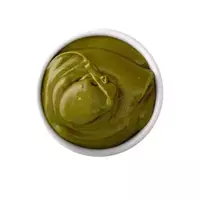Pistachio pasta

Connoisseurs call real pistachio paste the taste and aroma of a nut in its true embodiment. Externally, this food product is represented by a rather thick pasty mass, the distinctive features of which are the greenish-brown color and the pronounced smell of pistachios.
In fact, pistachio paste is unusually convenient and can be said to be universal types of semi-finished products that are used in confectionery as an additional component in the production of a number of confectionery creams, glazes, fillings, nougat, desserts. In general, pistachio paste can be found in many other types of products, which are usually classified as elite.
High-quality pistachio paste can give the finished product a truly unique taste - exquisite, elegant and original. In addition, when you add pistachio paste as a natural dye to a white glaze, you can get not only the delicate pistachio taste of this glaze, but also achieve a pleasant greenish shade of the finished product.
The modern food industry produces two varieties of pistachio paste - flavored and natural. It is clear that the latter option is much more expensive, which is due to the use of extremely high-quality raw materials.
Flavored pistachio pasta can become one of the ingredients in dessert dishes, chocolates, cookies, cakes, cakes or creams. However, it is believed that it is best to use not flavoured, but all-natural pistachio paste to make ice cream.
The beneficial properties of high-quality pistachio paste are its high nutritional value. By the way, according to numerous experts of the National American Food Institute, pistachio is characterized by the greatest nutritional value in combination with a high content of vitamins, amino acids and minerals.
And no wonder this nut has another, one of the oldest name - magic nut, which translates as magic nut. The homeland of pistachio is considered to be the countries of the Middle East and Central Asia, where these delicious nuts have been cultivated for many centuries.
Before directly using pistachio paste in cooking, it is recommended to mix the product thoroughly in order to achieve the necessary uniformity. At the same time, sometimes oil can be released on the surface of pistachio paste, but this is completely natural for this natural product.
The shelf life of industrial pistachio paste is limited to one year, and storage conditions provide for a temperature not higher than 5-7 ° C with tightly closed packaging after use.
The composition of pistachio paste, which can be purchased, as a rule, in specialized confectionery stores, includes pistachios themselves, a flavoring agent, as well as a number of dyes, in particular orange yellow S, quinoline yellow and proprietary blue V.
pistachio paste 696 kCal
Energy value of pistachio paste (Ratio of proteins, fats, carbohydrates - ju):
Proteins: 27.4 g (~ 110 kCal)
Fats: 60.4 g (~ 544 kCal)
Carbohydrates: 10.6 g (~ 42 kCal)
Energy ratio (bj | y): 16% | 78% | 6%
 Español
Español Français
Français Português
Português Русский
Русский 简体中文
简体中文 繁體中文
繁體中文 日本語
日本語 한국어
한국어 العربية
العربية Türkçe
Türkçe Қазақ
Қазақ Deutsch
Deutsch Italiano
Italiano Українська
Українська
